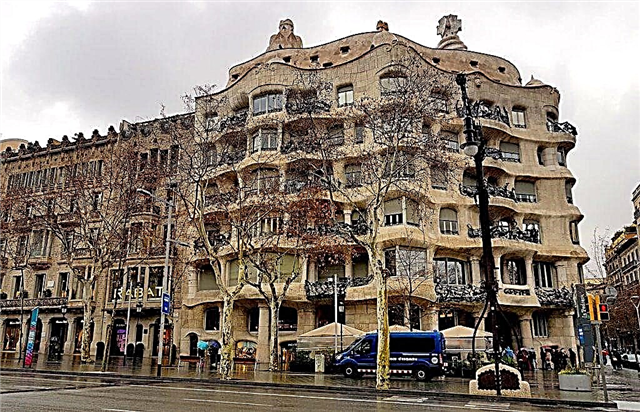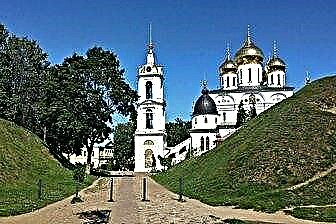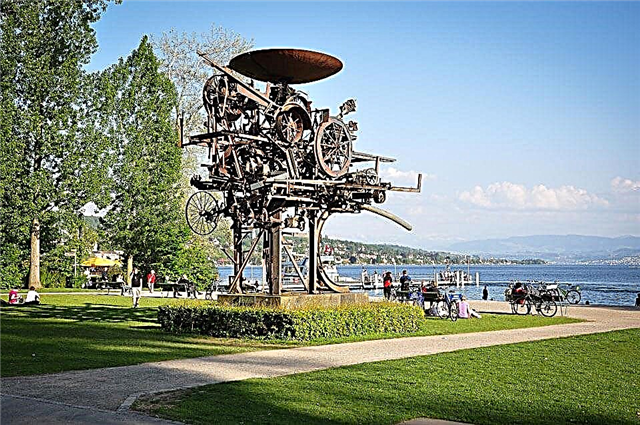Today there are two monasteries for men and two for women within the city. Their fate is closely related to the history of the city. In the 20th century, the old monasteries had to go through difficult trials. Today, Orthodox monasteries are being restored and are attracting many pilgrims and tourists.
Alexander Nevsky Lavra

General view of the Alexander Nevsky Lavra
In our country, there are only two large monasteries with a special status. One Lavra is located in Sergiev Posad, and the other is in the cultural capital of Russia.
The Alexander Nevsky Lavra was founded by Tsar Peter I in honor of the victory in a long and bloody war between Russia and Sweden. At the beginning of the 18th century, there was only one wooden church in the monastery, but already in 1717, stone development began according to the project of the talented architect Domenico Trezzini. The monastery received the status of a Lavra in 1797.
After the revolution, the monastery ensemble was recognized as an architectural monument, but for several decades the buildings were used by the House of Pioneers and the school. There were warehouses, a motor depot and dormitories for workers. Only in the mid-1990s, the old monastery was returned to believers.

View of the Annunciation Church and the Annunciation Gate of the Alexander Nevsky Lavra
The central place in the monastery is occupied by the majestic Holy Trinity Cathedral, built in the second half of the 18th century. The oldest surviving temple is the Annunciation Church. Members of the imperial family, Russian statesmen and diplomats are buried in her tomb.
The main shrine of the Lavra is the relics of the Blessed Prince Alexander Nevsky, which were returned to the monastery in 1989. Tourists come here to see ancient temples and visit the unique memorial necropolises.
The oldest Lazarevskoye cemetery was created in the 18th century. At the Tikhvin necropolis, masters of arts and writers are buried: composers A.S. Arensky, M.A. Balakirev, D. Bortnyansky and M.P. Mussorgsky, poets E. A Baratynsky, V. Zhukovsky and A. Delvig, writers F. M Dostoevsky and N.M. Karamzin. On their graves you can see beautiful monuments and tombstones.

General view of the Trinity Cathedral of the Alexander Nevsky Lavra
Lavra's cemeteries are open daily from 10:00 to 17:30. The ticket costs 250 rubles (2019). Please be aware that ticket offices stop selling tickets half an hour before closing time.
Divine services. Services in the monastery churches are held from Monday to Saturday at 7:00, 10:00 and 17:00. On Sundays, the liturgy starts at 9:00.
How to get there. The Lavra is located on the left bank of the Neva, near the metro station "Alexander Nevsky Square".
Holy Trinity Sergius Primorskaya Hermitage

General view of the Sergievo Primorskaya Hermitage
The monastery appeared during the reign of the Russian Empress Anna Ioannovna. The Empress granted her sister's country estate as a monk - the manor, which had previously belonged to Princess Catherine Ioannovna.
The new monastery occupied a modest plot of land with a wooden fence. In the middle there was a small temple, and around it were the monks' cells and the abbot's house. In the 1750s and 1760s, the architect Pietro Antonio Trezzini drew up a project and the wooden buildings were rebuilt in stone.
The monastery flourished in the 1830s, when Archimandrite Ignatius (Brianchaninov) was its abbot. Under him, the fraternal buildings were connected by a gallery, and the monastery churches were completely renovated.

View of the Sergievo Primorskaya desert from the St. Petersburg highway
Before the revolution, there were 7 churches in the desert, and 100 monks lived. Then the situation in the country changed dramatically. In 1919 the monastery was closed. Some of the monks were sent into exile, and some were left to live in the children's labor commune created here.
The architectural ensemble was badly damaged in the 1930s and during the war. In 1960, during the struggle of N. Khrushchev with religion, the old Trinity Cathedral was blown up.
Today the Holy Trinity Sergius Hermitage is a functioning monastery. Several churches in the 18th-19th centuries and the burial place of the Russian diplomat and statesman, Prince Alexander, Mikhailovich Gorchakov, have survived here. Some of the buildings have been restored, but some buildings still need restoration.

Icon of Christ the Savior over the holy gates
Divine services. The men's abode is open to pilgrims and tourists from 7:30 am to 9:00 pm. Church services are held every day: on weekdays at 9:00 and 17:00, and on Saturday and Sunday at 10:00 and 17:00.
How to get there. The monastery is located on the outskirts of the city towards Peterhof - on St. Petersburg highway, 15. If you want to get there by train, get off at the Sergievo station. Buses and minibuses run from the metro stations Avtovo, Prospekt Veteranov, Leninsky Prospekt and Baltiyskaya. You need to get off at the bus stop "Prospect Budyonny".
John's monastery

View of the Ioannovsky Monastery from the Karpovsky Bridge
On the banks of the small river Karpovka, a tributary of the Neva, rises a magnificent monastery ensemble in the neo-Byzantine style. The Orthodox monastery was founded at the beginning of the last century by a revered priest - John of Kronstadt. The monastery is dedicated to John of Rila, a Bulgarian saint who lived in the 10th century. The relics of John of Kronstadt rest in the tomb church.
The unusual buildings were designed by the St. Petersburg architect Nikolai Nikitich Nikonov. Before the revolution, 350 nuns and novices lived here. They had their own subsidiary farm, worked in a hospital, an orphanage and workshops. During the First World War, the nuns set up an infirmary and nursed wounded soldiers and officers.
In 1919, a labor commune appeared instead of the monastery. Then the buildings were transferred to the technical school of land reclamation, and the nuns were arrested and sent into exile in Kazakhstan.

The domes of the church in the name of the Twelve Apostles of the Ioannovsky Monastery
The old monastery was returned to the Church in 1989. For several years, the offices that occupied the former churches left, and since 1991 the monastery life has gone on as usual.
Temples and other buildings were restored or rebuilt from the surviving drawings and photographs. Today, on the territory you can see a huge temple of the Twelve Apostles, the Church of St. John of Rylsky, the Pokrovskaya chapel and the tomb.
Divine services. Believers can come to the service every day at 8:00 and 17:00. On Sunday the Liturgy begins at 9:00.
How to get there. The monastery is located in the Petrogradsky district of the city, at the address: Karpovka embankment, 45. In 15 minutes the monastery can be reached on foot from the Petrogradskaya metro station.
Resurrection Novodevichy Convent

General view of the Resurrection Novodevichy Convent
Another nunnery in the city dates back to the 40s of the 18th century. It was created on the site of the Smolny Dvor by the order of the daughter of Peter I - the Russian Empress Elizabeth Petrovna. The project for the first buildings was prepared by the famous architect Bartolomeo Rastrelli.
At the end of the 18th century, the convent was abolished and rebuilt on Vasilievsky Island, and in 1848 it was given a land plot outside the Moscow outpost. Before the revolution, more than 400 nuns and novices lived in the monastery. They prayed and worked tirelessly. There were 8 churches on the territory. The monastery had its own stable, stockyard and poultry house. Women worked in gold embroidery, carpet and icon painting workshops, helped in a hospital and an orphanage.
From 1918 to 1938, the monastery was completely destroyed. Almost all the churches were demolished, the bell tower was blown up, and the nuns were evicted from the city. The remaining buildings were rebuilt for the needs of the Research Institute of Electrical Engineering.

View of the Kazan Church of the Resurrection Novodevichy Convent from the cemetery
Church life began to revive in the monastery since the mid-1990s. Today the monastery has been completely restored. There is a sewing workshop, a church shop, an almshouse, an orphanage and a Sunday school.
Tourists come to see one of the most beautiful cathedrals and temples in St. Petersburg - the five-domed Resurrection Cathedral. It was built in the middle of the 19th century, at the same time as the monastery.
Nearby there is a picturesque Kazan temple, which was erected at the beginning of the last century by the project of the architect Vasily Antonovich Kosyakov. The squat neo-Byzantine church has luxurious interiors. It is decorated with wall paintings and three carved iconostases.

Resurrection Cathedral of the Resurrection Novodevichy Convent
Divine services. From Tuesday to Friday, church services are held at 7:00 and 17:00, on Saturday at 9:00 and 16:00, on Sunday at 7:00, 9:40 and 17:00, and on Monday at 9:00 and 17:00.
How to get there. The monastery is located at 100 Moskovsky Prospekt, 0.8 km from the Moskovskie Vorota metro station.











